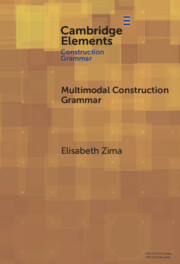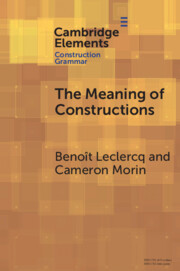Refine search
Actions for selected content:
6584 results in Grammar and Syntax
9 - Discussion and Conclusion
-
- Book:
- Pattern, Construction, System
- Published online:
- 21 August 2025
- Print publication:
- 04 September 2025, pp 220-237
-
- Chapter
-
- You have access
- Open access
- HTML
- Export citation
6 - Constructions in Meaning Networks: Causation
-
- Book:
- Pattern, Construction, System
- Published online:
- 21 August 2025
- Print publication:
- 04 September 2025, pp 105-130
-
- Chapter
-
- You have access
- Open access
- HTML
- Export citation
Index
-
- Book:
- Pattern, Construction, System
- Published online:
- 21 August 2025
- Print publication:
- 04 September 2025, pp 245-248
-
- Chapter
-
- You have access
- Open access
- HTML
- Export citation
7 - Semantic Fields: Cognition and Communication
-
- Book:
- Pattern, Construction, System
- Published online:
- 21 August 2025
- Print publication:
- 04 September 2025, pp 131-177
-
- Chapter
-
- You have access
- Open access
- HTML
- Export citation
4 - Semantic Role Annotation
-
- Book:
- Pattern, Construction, System
- Published online:
- 21 August 2025
- Print publication:
- 04 September 2025, pp 57-84
-
- Chapter
-
- You have access
- Open access
- HTML
- Export citation
3 - From Pattern to Constructions
-
- Book:
- Pattern, Construction, System
- Published online:
- 21 August 2025
- Print publication:
- 04 September 2025, pp 25-56
-
- Chapter
-
- You have access
- Open access
- HTML
- Export citation
1 - Introduction
-
- Book:
- Pattern, Construction, System
- Published online:
- 21 August 2025
- Print publication:
- 04 September 2025, pp 1-10
-
- Chapter
-
- You have access
- Open access
- HTML
- Export citation
Dedication
-
- Book:
- Pattern, Construction, System
- Published online:
- 21 August 2025
- Print publication:
- 04 September 2025, pp v-vi
-
- Chapter
-
- You have access
- Open access
- HTML
- Export citation
8 - Semantic Fields: Material and Relational
-
- Book:
- Pattern, Construction, System
- Published online:
- 21 August 2025
- Print publication:
- 04 September 2025, pp 178-219
-
- Chapter
-
- You have access
- Open access
- HTML
- Export citation
References
-
- Book:
- Pattern, Construction, System
- Published online:
- 21 August 2025
- Print publication:
- 04 September 2025, pp 238-244
-
- Chapter
-
- You have access
- Open access
- HTML
- Export citation
Figures
-
- Book:
- Pattern, Construction, System
- Published online:
- 21 August 2025
- Print publication:
- 04 September 2025, pp ix-x
-
- Chapter
-
- You have access
- Open access
- HTML
- Export citation
Copyright page
-
- Book:
- Pattern, Construction, System
- Published online:
- 21 August 2025
- Print publication:
- 04 September 2025, pp iv-iv
-
- Chapter
-
- You have access
- Open access
- HTML
- Export citation
2 - Background to Pattern Grammar and Construction Grammar
-
- Book:
- Pattern, Construction, System
- Published online:
- 21 August 2025
- Print publication:
- 04 September 2025, pp 11-24
-
- Chapter
-
- You have access
- Open access
- HTML
- Export citation
Tables
-
- Book:
- Pattern, Construction, System
- Published online:
- 21 August 2025
- Print publication:
- 04 September 2025, pp xi-xi
-
- Chapter
-
- You have access
- Open access
- HTML
- Export citation

Multimodal Construction Grammar
-
- Published online:
- 25 August 2025
- Print publication:
- 25 September 2025
-
- Element
- Export citation

Pattern, Construction, System
- A Unified Approach to Grammar and Lexis
-
- Published online:
- 21 August 2025
- Print publication:
- 04 September 2025
-
- Book
-
- You have access
- Open access
- Export citation

Unrealized Arguments and the Grammar of Context
-
- Published online:
- 31 July 2025
- Print publication:
- 04 September 2025
-
- Element
- Export citation

The Meaning of Constructions
-
- Published online:
- 16 May 2025
- Print publication:
- 22 May 2025
-
- Element
- Export citation
Acknowledgements
-
- Book:
- Composite Predicates in English
- Published online:
- 09 May 2025
- Print publication:
- 15 May 2025, pp xvi-xvii
-
- Chapter
- Export citation
Tables
-
- Book:
- Composite Predicates in English
- Published online:
- 09 May 2025
- Print publication:
- 15 May 2025, pp x-xv
-
- Chapter
- Export citation
